Brian Van Fleet
Pretty Fly for a Bonsai Guy
Ok, here is my update since my original bottom trees are gone, and one of my two top trees is dead. My remaining original top tree is my shimpaku, which is resting for a year or two and still on my list. I have (too many) projects going in training pots, and in the ground which I’m not counting. I’m also not considering Shohin trees on this list.
Here are my new bottom trees.
A. Shimpaku
1. Shimpaku from Evergreen Gardenworks, vintage Chinese pot.
2. I have put about 5 years into it now, originally styled by Bonsai Crazy, and later with Bjorn.
3. It’s on the list because I don’t care for semi-cascades, I don’t like the styling, and it is weak in the middle section, so it looks like it has a hat and a tail.
4. It is still on my bench because I’d be upside down if I sold it for less than $600, and I don’t think it would fetch $600. I am also not excited about packing it to ship.
5. I might try to find a new planting angle standing it more upright in the ground for a while, or I might accept the loss and let it go.
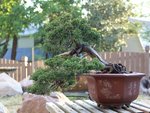
B. Rocky Mountain Juniper
1. Collected RMJ, collected by me in 2013, in a pot by Zenigo.
2. I have put 7 years into this one, all in reducing the size, carving, and grafting to change foliage to Itoigawa.
3. It’s on the list because I really don’t see a great design in the trunk yet. But I’m eager to do some styling on the grafted foliage this fall and see if it will emerge. It could also stand some carving on the trunk to add some movement, interest, and drama.
4. I still have it because it takes time to acclimate a collected RMJ here, and to change the foliage. Since I collected it, I’m a bit sentimentally attached to it.
5. Plan is to eliminate original foliage this year, and wire the Itoigawa foliage in the fall, maybe do some carving to define live veins.
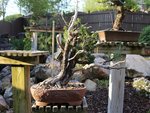
C. Corkbark black pine, ‘Taihei’
1. Corker JBP, pot is a Yixing Zisha.
2. Had it for 12 years.
3. On the list because they’re relatively uncooperative to style.
4. Still have it because the bark takes 20 years or so to develop, so as long as it stays healthy, I’ll keep it and basically ignore it 364 days a year.
5. Plan, accept it for what it is, and keep the foliage close to the trunk. Maybe in 20 years the bark will be cool enough to keep its place on the bench.
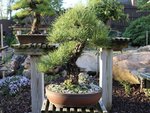
Top trees:
A. Shimpaku
1. imported Shimpaku, Gyouzan pot.
2. I’ve had it for 7 years or so, worked on it with Bjorn 3 different times.
3. Top tree because it’s “classic” style and presence on the benches.
4. No plans right now, it went to the USNBE in 2016, and the Carolina Bonsai Expo, and I’m not planning to show it again for a while.
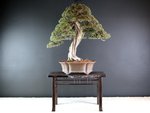
B. Japanese Black Pine
1. Container-grown JBP from Brussels Bonsai. Gyouzan pot.
2. I bought it in 2007, originally styled by Peter Warren in 2011, recently worked with Bjorn last June.
3. Top tree because it’s really coming into its own, and has good bones for the future. Good, manageable size (24”), great bark, good base and trunk movement..
4. No plans right now. Doubt it will ever be a USNBE contender, but will be a good local show piece.
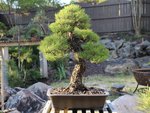
C. Japanese Black Pine
1. Container-grown JBP from Brussels Bonsai. Antique Chinese pot.
2. I bought it in 2007, all my work with the exception of wiring tweaks by Bjorn in 2017.
3. Top tree because it’s got good trunk movement, a nice refined base developing, and well-ramified branching. It’s also the subject of my book on JBP, so I’m committed.
4. I need to wire it again when I candle-cut this summer. It was accepted into the USNBE in 2018, but I withdrew it because it wasn’t in perfect health. I may submit it again for this year‘s show. It’s small (15”), so it will likely get swallowed up by the larger entries, even as part of a 3-point display.
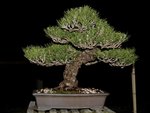
Here are my new bottom trees.
A. Shimpaku
1. Shimpaku from Evergreen Gardenworks, vintage Chinese pot.
2. I have put about 5 years into it now, originally styled by Bonsai Crazy, and later with Bjorn.
3. It’s on the list because I don’t care for semi-cascades, I don’t like the styling, and it is weak in the middle section, so it looks like it has a hat and a tail.
4. It is still on my bench because I’d be upside down if I sold it for less than $600, and I don’t think it would fetch $600. I am also not excited about packing it to ship.
5. I might try to find a new planting angle standing it more upright in the ground for a while, or I might accept the loss and let it go.

B. Rocky Mountain Juniper
1. Collected RMJ, collected by me in 2013, in a pot by Zenigo.
2. I have put 7 years into this one, all in reducing the size, carving, and grafting to change foliage to Itoigawa.
3. It’s on the list because I really don’t see a great design in the trunk yet. But I’m eager to do some styling on the grafted foliage this fall and see if it will emerge. It could also stand some carving on the trunk to add some movement, interest, and drama.
4. I still have it because it takes time to acclimate a collected RMJ here, and to change the foliage. Since I collected it, I’m a bit sentimentally attached to it.
5. Plan is to eliminate original foliage this year, and wire the Itoigawa foliage in the fall, maybe do some carving to define live veins.

C. Corkbark black pine, ‘Taihei’
1. Corker JBP, pot is a Yixing Zisha.
2. Had it for 12 years.
3. On the list because they’re relatively uncooperative to style.
4. Still have it because the bark takes 20 years or so to develop, so as long as it stays healthy, I’ll keep it and basically ignore it 364 days a year.
5. Plan, accept it for what it is, and keep the foliage close to the trunk. Maybe in 20 years the bark will be cool enough to keep its place on the bench.

Top trees:
A. Shimpaku
1. imported Shimpaku, Gyouzan pot.
2. I’ve had it for 7 years or so, worked on it with Bjorn 3 different times.
3. Top tree because it’s “classic” style and presence on the benches.
4. No plans right now, it went to the USNBE in 2016, and the Carolina Bonsai Expo, and I’m not planning to show it again for a while.

B. Japanese Black Pine
1. Container-grown JBP from Brussels Bonsai. Gyouzan pot.
2. I bought it in 2007, originally styled by Peter Warren in 2011, recently worked with Bjorn last June.
3. Top tree because it’s really coming into its own, and has good bones for the future. Good, manageable size (24”), great bark, good base and trunk movement..
4. No plans right now. Doubt it will ever be a USNBE contender, but will be a good local show piece.

C. Japanese Black Pine
1. Container-grown JBP from Brussels Bonsai. Antique Chinese pot.
2. I bought it in 2007, all my work with the exception of wiring tweaks by Bjorn in 2017.
3. Top tree because it’s got good trunk movement, a nice refined base developing, and well-ramified branching. It’s also the subject of my book on JBP, so I’m committed.
4. I need to wire it again when I candle-cut this summer. It was accepted into the USNBE in 2018, but I withdrew it because it wasn’t in perfect health. I may submit it again for this year‘s show. It’s small (15”), so it will likely get swallowed up by the larger entries, even as part of a 3-point display.


